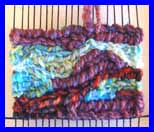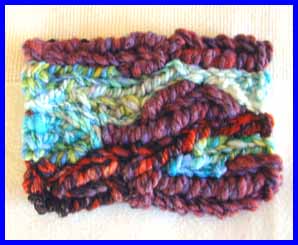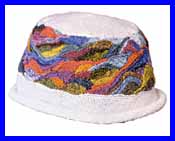
Very carefully trim the last of the tail away. Do NOT cut the warp thread too... that would be a bad thing to do. The photo to the right shows a new colour yarn attachment to the far left edge.


|
Very carefully trim the last of the tail away. Do NOT cut the warp thread too... that would be a bad thing to do. The photo to the right shows a new colour yarn attachment to the far left edge. |

|

|
When you have worked a row of knots out to the edge of the weaving on the right, you will notice that there is a gap or "slit". If this gap is only for 2 or 3 rows, it will not be noticeable in the finished weaving.If one weaves many rows and leaves this vertical slit, then after the weaving is finished, go back with black thread and join the edges together. Another way to avoid this gap is to alternate (by working 2 colours at the same time) first the row on the right, then the row on the left. Overlap one knot at the end of each row... first one colour, then the other. This would look sort of like a "dovetail" join in the finished weaving. |
Turn the weaving around and tie off the bottom edge warp threads in the same way. It's a good idea to press the finished weaving with a damp cloth and the iron set to "steam" and "wool". The threads can be trimmed, pressed, and hidden on the back side of the weaving.
This small sample that was woven as a demonstration had only 120 knots. A large tapestry woven with finer yarns would have thousands of knots. This is the sort of work that can go on for hours or months, depending on the scale of the yarns or threads and the size of the work. A word of caution: this seems to be the sort of work that either you will find more frustrating than you can stand, or an obsessive compulsion that you can't put down. Best of luck with this new interest and write if you have questions.
[an error occurred while processing this directive]
The next photos show the progression of the weaving.





It's time to cut the warp threads and remove the weaving from the loom.
Starting at the left top edge, tie the first 2 warp threads together in a square knot. Use the right hand thread and tie to the next thread to the right. Work this way across from left to right until all of the warp threads are tied off. Be sure to have tied into the knot that last yarn tail, when you reach it in the weaving. It too can be pressed to the back side of the weaving.


If you want to mount the tapestry (to be framed) use black picture matting board. On the back side, draw a square (rectangle, circle, or whatever shape the tapestry is) that is the size of the finished tapestry. Mark a point every 1/2 inch. Use a hammer and small finish nail to make holes in the board on these marked points. Sew the tapestry to the board using monofilament (clear fishing line) and the pre-made holes.
Soumak weaving techniques can be made into a number of objects. You will have woven a piece of fabric that can be sewn into anything that one would normally make out of cloth. This could include anything from a postage stamp sized tapestry, to a tapestry box, a tapestry bag, a hat, or a 6 foot X 6 foot rug. Most anything that you can think of to do.



The web server charges a bandwidth transfer fee every time someone downloads one of our free instructional pages.
Please help the sheep pay for downloading this page.
Click on the Typing Sheep above to make your donation using Paypal.
Your donation is gratefully accepted ... thank you, thank you, thank you!